Ancient tomb containing mummy and 180 figurines found in Egypt
An ancient tomb containing a well-preserved Egyptian mummy in a limestone sarcophagus and a collection of 180 ushabti figurines have been found in a newly-discovered tomb in Egypt’s northern province of Dakahliya.
Archaeologists uncovered the burial during routing excavation work at the Tel Tabla archaeological site in the Delta city of Dakahliya. The tomb is a mud brick mastaba tomb (meaning “house for eternity”) dating back to the Late Ancient Egyptian period (712-323 BC) and contains a number of burial shafts.
A mastaba tomb is a type of ancient Egyptian tomb in the form of an above ground, flat-roofed, rectangular structure with outward sloping sides that marked the burial site of many eminent Egyptians. They were built with a north-south orientation which was essential for Egyptians so that they may be able to access the afterlife. This above ground structures had space for a small offering chapel equipped with a false door to which priests and family members brought food and other offerings for the soul of the deceased.
Minister of State for Antiquities Mohamed Ibrahim said that inside one of the burial shafts, excavators uncovered a limestone anthropoid sarcophagus of a lady called Werty, the daughter of Rtrs, with Werty’s mummy in a well preserved condition inside. Beside the sarcophagus, a large collection of 180 ushabti figurines carved in wood and limestone was unearthed.
The ushabti (“answerers”) are a funerary figurine used in Ancient Egypt which were placed in tombs and were intended to act as substitutes for the deceased, should he/she be called upon to do manual labour in the afterlife. The figurines typically carried a hoe on their shoulder and a basket on their backs. They usually carried inscriptions asserting their readiness to answer the gods' summons to work.
The sarcophagus lid features Werty's figure with her arms crossed over her chest in the Osirian position and is engraved with ancient Egyptian prayers on the lid. Excavators are continuing their work to uncover more funerary objects.
Featured image: An example of a mastaba tomb and typical interior layout (please note: this is not the mastaba tomb found in Dakahliya).



















